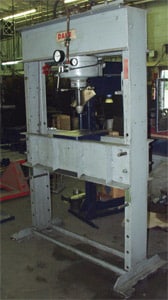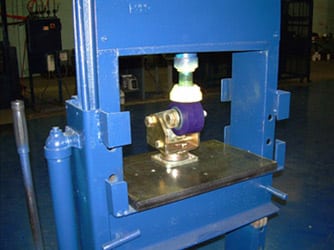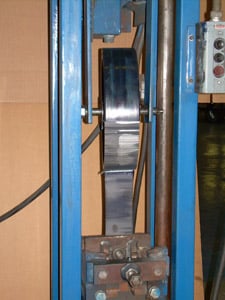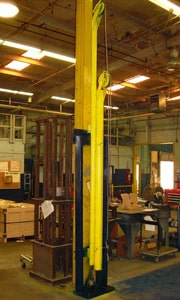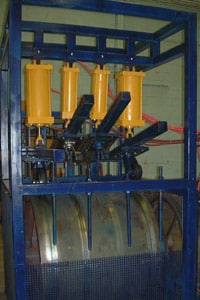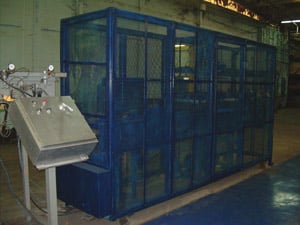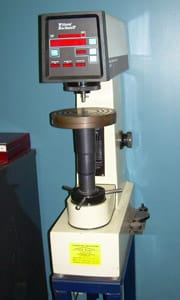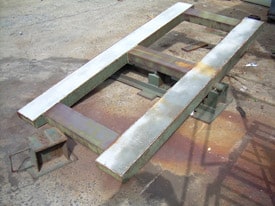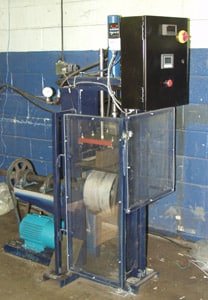RWM Casters has the ability to test industrial casters and wheels using various testing platforms that allow us to verify fit, function, durability, and the feasibility of new and existing designs. We bring you the advantage of extensive testing at every stage, from initial design to manufacturing. Every caster and wheel that we sell has passed real-world tests of durability and severe in-house tests such as the Drop Test, Drum Test, Adhesion Test, and Cart Push/Pull Test. The following list provides more detailed information for all of our in-house testing. In addition to these, we can perform additional tests if required, including, but not limited to, Chemical Composition Analysis, Metallographic Examination, Microhardness Profile, and various structural testing protocols.
Static Load Testing
In addition to our two 10-ton hydraulic presses used for static load, shock absorber height, and rebound testing, we also possess Dake 75-ton and Vickers 80-ton Hydraulic presses for testing our kingpinless casters and raceways. The caster is mounted upside down on a custom 1″ thick ribbed mounting plate, and load is applied to the caster’s wheel at increments based on load capacity for one-minute intervals. Notes are taken at each load increment, and the caster is taken to the point of failure or to the machine maximum (whichever occurs first), which is then used to compute the maximum recommended sustained load capacity rating. Some caster rigs may exceed the capabilities of these machines and are sent to outside locations for further testing.
Shock Absorber Testing
Starting with the basics, we have two (2) 10-ton manual hydraulic presses, which can reach up to 22,000 lbs of pressure. These presses are used to test shock absorber spring rates and ride heights. They are also used for testing the rebound capabilities of various wheel materials. Placing the complete caster in the hydraulic press and taking measurements before and after pressure is applied tests spring rates and ride heights. This information is used to monitor existing processes and to assist engineering with new product development.
Rebound Testing
Testing the rebound properties of various types of wheel materials is also accomplished using the hydraulic press. The specimen is attached to the machine bedplate, pressure is then applied to the wheel for a specified length of time depending on what type and size of wheel is being tested. The wheel is then removed and inspected. The wheel should return to its original shape after a given period of time. Footprint measurements can also be taken to calculate ground pressure.
Adhesion Test
Adhesion Test Another testing platform is the adhesion test machine (see figure. 2). This machine uses force to separate the tread from the wheel core and is used to determine if the tread is attached properly to the core. The specimen is cut in such a manner that a 5-inch flap of the tread material is created, which is then clamped in the tester vise. The wheel is then mounted to the machine, and the operator begins the test. The machine removes the tread from the wheel core by moving the wheel away from the vise using an electric motor to turn a ball screw at a rate of 6 inches per minute. The vise is attached to a cylinder, which has a pressure gage (PSI) to measure the resistance of the pull force during the test. The operator monitors the pressure gage, and the results are compared to the RWM Adhesion parameters to determine if the sample passed or failed the test.
Drop Test
Drop Test The drop test is used to verify the integrity of the caster’s swivel function. A solid steel type wheel is used in the caster, and the caster is mounted to the test stand. A 25 lb. weight is allowed to free fall onto the wheel of the caster starting at 1ft. and continuing to 10 ft., or failure, whichever occurs first. The caster is inspected for function between each drop, and the results are documented. This is also used to test the structural integrity and impact resistance of many RWM Casters wheel products.
Drum Test With Obstacle
Download White Paper on Drum Testing »
The Drum tester is used to verify the integrity of the wheel tread and bearings simulating real-world conditions. The machine uses a steel-rotating drum that has a circumference of 10.9956 feet, that is turned with an electric motor that can be adjusted from 1 MPH to 15 MPH. Various size steel plates can be mounted to the drum to act as obstacles. The thicknesses of the plates are approximately 2.19% of the wheel diameter and are chamfered on the side that impacts the wheels. They are spaced so that they impact the wheel every 6 feet of travel.
The casters are mounted to plates that are attached to cylinders located above the rotating drum. The cylinders apply pressure to the caster keeping them in contact with the rotating drum. The cylinder pressure can be adjusted depending on the type and size of wheel being tested. The length of time the wheels are in contact with the drum can also be controlled. The test normally runs for two (2) hours with the wheel contacting the drum for three (3) minutes, and then resting off of the drum for one (1) minute. This cycle is repeated for the duration of the test. The test is concluded after 2 hours or if a failure occurs. The maximum diameter wheel that can be tested is 12 inches, and the maximum pressure that can be applied is 5000 pounds.
Drum Test Endurance
The endurance test is similar to the obstacle test. The steel obstacles are removed and the test is run for 8 hours, or until the wheel fails, whichever occurs first.
Cart Push/Pull Test
This test is used to calculate the average force needed to move a cart loaded with various weights and having different caster orientations. The cart is constructed of mild steel and measures approximately 4 x 5 feet and weighs 500 pounds. We have an additional 1500 pounds of weight, which can be added to the cart for a total of 2000 pounds. The cart is contained by guide rails, which keep the cart from leaving the test platform. The push handle end of the cart is attached to an electric motor by means of an “S” type load cell which measures resistance in pounds, equal to the force needed to move the cart. The load cell is then attached to a computer that gathers the data during the testing phase. The cart is initially tested at the cart weight of 500 pounds. Weight is then added in 500-pound increments until we reach 2000 total pounds. We test the casters to determine how much force it takes to move them in both directions, which is called rolling resistance. We also test the swivel capability of the casters to determine the breakaway force needed to move them from various positions, such as 90 degrees to the cart axis and opposing one another. This test is used to simulate real-world conditions the data collected is analyzed by our engineering group who then uses this information to determine the proper application for various types and combinations of wheels and casters. Special tests can be scheduled to accommodate customer requirements.
C.F.T.M.A. Test
CFTMA Test The CFTMA testing platform is a custom made piece of equipment that was constructed to perform durability testing of swivel casters. The caster is mounted to the adaptor plate. An air cylinder applies a vertical load that is the maximum load rating for that particular caster and wheel combination, the slider mechanism moves the table of the test machine back and forth 4.5 ft. in each direction in a straight line underneath the wheel of the caster. Each time the table reverses direction the caster indexes 180 degrees. A cycle is completed once the table has moved the 4.5 ft. in one direction and then reverses and moves 4.5 ft. in the opposite direction. The test machine is run at a rate of 17 cycles per minute for an eight (8) hour time period or until the caster fails. At the completion of the test the wheel and casters are examined to meet RWM quality parameters.
Material Hardness Testing
Material Hardness Testing We have the capability to inspect the hardness of various types of materials using our Wilson Rockwell Testing Machine and our Shore Type Durometer.
Brake Test Ramp
Brake Test This device allows RWM to test the holding power of a braking system. Four casters are mounted to the bottom of the cart, which is then loaded to the desired weight. The brakes are engaged, and the ramp can be slanted up to 11.5 degrees.
Variable (High Speed) Drum Test Machine
Brake Test The test apparatus consists of a computer-controlled rotating drum assembly and a pneumatic piston. The caster is mounted to the bottom of the piston and is pressed into the rotating drum assembly. Using this system, RWM can test any caster under a myriad of different situations by varying the load on the caster and the speed at which the drum rotates.
Testing Other
In addition to the testing listed above, we can perform additional tests if required including but not limited to: Chemical Composition Analysis, Metallographic Examination, Microhardness Profile, and various structural testing protocols.

